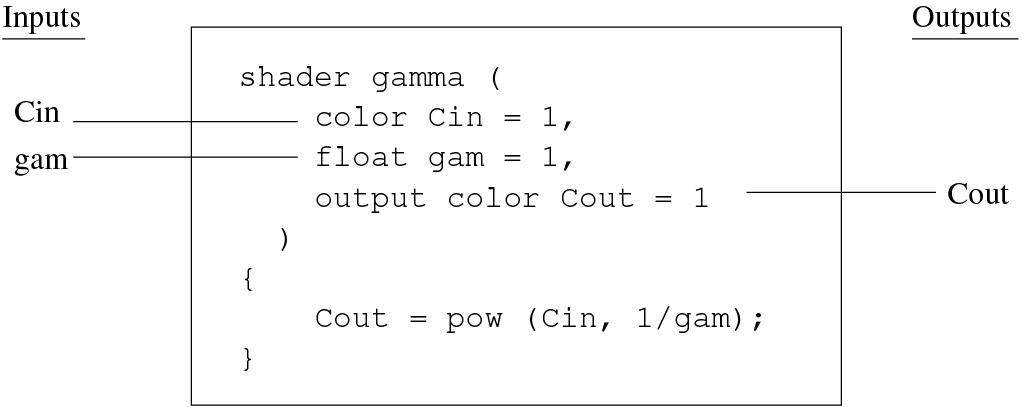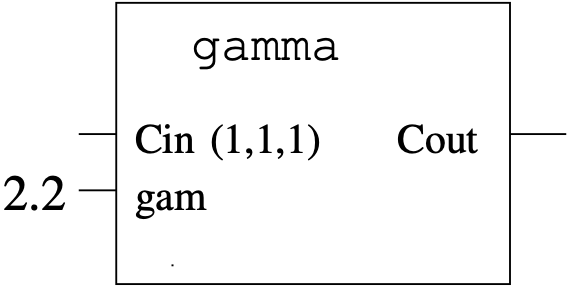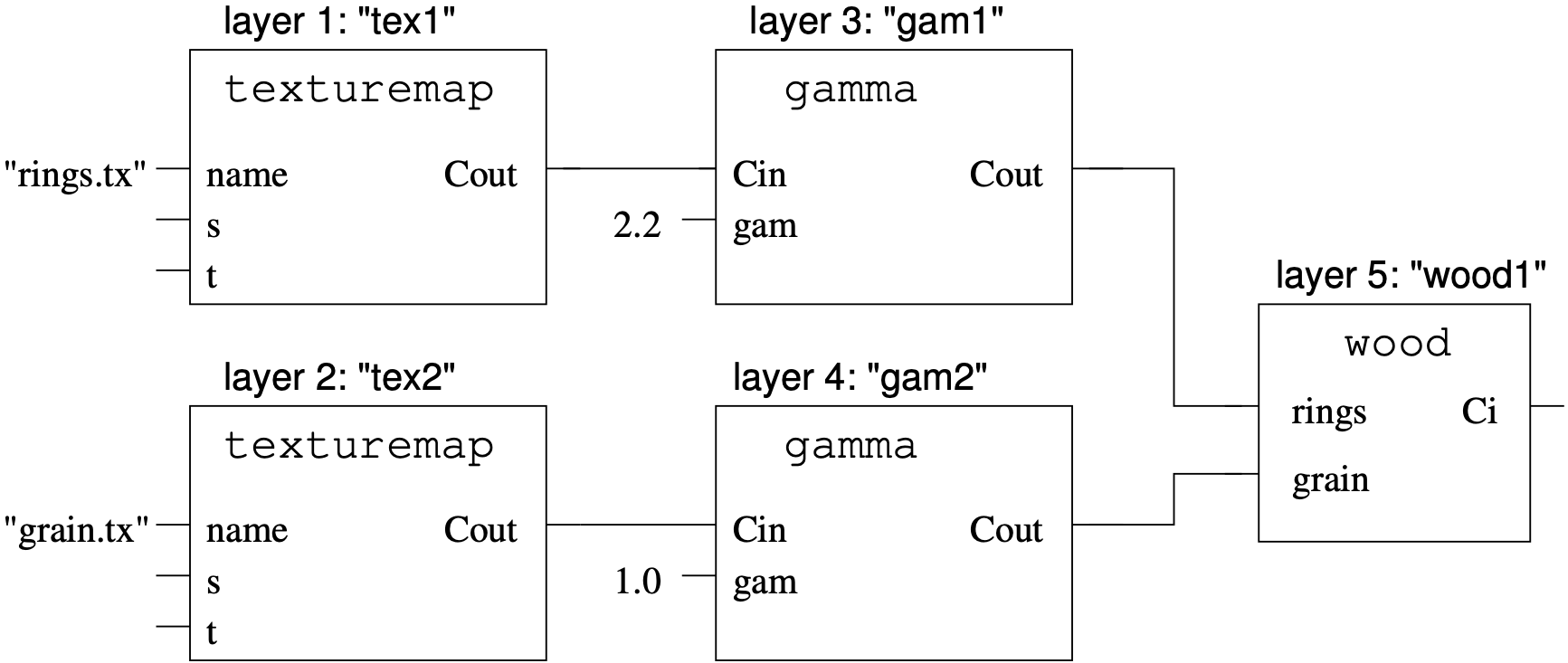(chap-bigpicture=)
2. The Big Picture#
This chapter attempts to lay out the major concepts of OSL, define key nomenclature, and sketch out how individual shaders fit together in the context of a renderer as a whole.
2.1. A shader is code that performs a discrete task#
A shader is a program, with inputs and outputs, that performs a specific task when rendering a scene, such as determining the appearance behavior of a material or light. The program code is written in OSL, the specification of which comprises this document.
For example, here is a simple gamma shader that performs
simple gamma correction on is Cin input, storing the result
in its output Cout:

The shader’s inputs and outputs are called shader parameters.
Parameters have default values, specified in the shader code, but may
also be given new values by the renderer at runtime.
2.2. Shader instances#
A particular shader may be used many times in a scene, on different objects or as different layers in a shader group. Each separate use of a shader is called a shader instance. Although all instances of a shader are comprised of the same program code, each instance may override any or all of its default parameter values with its own set of instance values.
Below is a schematic showing a gamma instance with the gam parameter
overridden with an instance-specific value of 2.2.

2.3. Shader groups, layers, and connections#
A shader group is an ordered sequence of individual shaders called layers that are executed in turn. Output parameters of an earlier-executed layer may be connected to an input parameter of a later-executed layer. This connected network of layers is sometimes called a shader network or a shader DAG (directed acyclic graph). Of course, it is fine for the shader group to consist of a single shader layer.
Below is a schematic showing how several shader instances may be connected to form a shader group.

And here is sample pseudo-code shows how the above network may be assembled using an API in the renderer [1]:
ShaderGroupBegin ()
Shader ("texturemap", /* shader name */
"tex1", /* layer name */
"string name", "rings.tx") /* instance variable */
Shader ("texturemap", "tex2", "string name", "grain.tx")
Shader ("gamma", "gam1", "float gam", 2.2)
Shader ("gamma", "gam2", "float gam", 1)
Shader ("wood", "wood1")
ConnectShaders ("tex1", /* layer name A */
"Cout", /* an output parameter of A */
"gam1", /* layer name B */
"Cin") /* Connect this layer of B to A's Cout */
ConnectShaders ("tex2", "Cout", "gam2", "Cin")
ConnectShaders ("gam1", "Cout", "wood1", "rings")
ConnectShaders ("gam2", "Cout", "wood1", "grain")
ShaderGroupEnd ()
Or, expressed as serialized text (as detailed in Chapter Describing shader groups:
param string name "rings.tx" ;
shader "texturemap" "tex1" ;
param string name "grain.tx" ;
shader "texturemap" "tex2" ;
param float gam 2.2 ;
shader "gamma" "gam1" ;
param float gam 1.0 ;
shader "gamma" "gam2" ;
shader "wood" "wood1" ;
connect tex1.Cout gam1.Cin ;
connect tex2.Cout gam2.Cin ;
connect gam1.Cout wood1.rings ;
connect gam2.Cout wood1.grain ;
The rules for which data types may be connected are generally the same as the rules determining which variables may be assigned to each other in OSL source code:
sourceanddestare the same data type.sourceanddestare both triples (color,point,vector, ornormal), even if they are not the same kind of triple.sourceis anintanddestis afloat.sourceis afloatorintanddestis a triple (the scalar value will be replicated for all three components of the triple).sourceis a single component of an aggregate type (e.g. one channel of acolor) anddestis afloat(or vice versa).
2.4. Geometric primitives#
The scene consists of primarily of geometric primitives, light sources, and cameras.
Geometric primitives are shapes such as NURBS, subdivision surfaces, polygons, and curves. The exact set of supported primitives may vary from renderer to renderer.
Each geometric primitive carries around a set of named primitive variables (also sometimes called interpolated values or user data). Nearly all shape types will have, among their primitive variables, control point positions that, when interpolated, actually designate the shape. Some shapes will also allow the specification of normals or other shape-specific data. Arbitrary user data may also be attached to a shape as primitive variables. Primitive variables may be interpolated in a variety of ways: one constant value per primitive, one constant value per face, or per-vertex values that are interpolated across faces in various ways.
If a shader input parameter’s name and type match the name and type of a primitive variable on the object (and that input parameters is not already explicitly connected to another layer’s output), the interpolated primitive variable will override the instance value or default.
2.5. Attribute state and shader assignments#
Every geometric primitive has a collection of attributes (sometimes called the graphics state) that includes its transformation matrix, the list of which lights illuminate it, whether it is one-sided or two-sided, shader assignments, etc. There may also be a long list of renderer-specific or user-designated attributes associated with each object. A particular attribute state may be shared among many geometric primitives.
The attribute state also includes shader assignments — the shaders or shader groups for each of several shader uses, such as surface shaders that designate how light reflects or emits from each point on a shape, displacement shaders that can add fine detail to the shape on a point-by-point basis, and volume shaders that describe how light is scattered within a region of space. A particular renderer may have additional shader types that it supports.
2.6. Shader execution state: parameter binding and global variables#
When the body of code of an individual shader is about to execute, all its parameters are bound — that is, take on specific values (from connections from other layers, interpolated primitive variables, instance values, or defaults, in that order).
Certain state about the position on the surface where the shading is being run is stored in so-called global variables. This includes such useful data as the 3D coordinates of the point being shaded, the surface normal and tangents at that point, etc.
Additionally, the shader may query other information about other elements of the attribute state attached to the primitive, and information about the renderer as a whole (rendering options, etc.).
2.7. Surface and volume shaders compute closures#
Surface shaders (and volume shaders) do not by themselves compute the final color of light emanating from the surface (or along a volume). Rather, they compute a closure, which is a symbolic representation describing the appearance of the surface, that may be more fully evaluated later. This is in effect a parameterized formula, in which some inputs have definite numeric values, but others may depend on quantities not yet known (such as the direction from which the surface is being viewed, and the amount of light from each source that is arriving at the surface).
For example, a surface shader may compute its result like this:
color paint = texture ("file.tx", u, v);
Ci = paint * diffuse (N);
In this example, the variable paint will take on a specific numeric
value (by looking up from a texture map). But the diffuse() function
returns a color closure, not a definite numeric color. The output
variable Ci that represents the appearance of the surface is also a color closure, whose numeric value is not known yet, except that it will be the
product of `paint`` and a Lambertian reflectance.

The closures output by surface and volume shaders can do a number of interesting things that a mere number cannot:
Evaluate: given input and output light directions, compute the proportion of light propagating from input to output.
Sample: given just an input (or output) direction, choose a scattering direction with a probability distribution that is proportional to the amount of light that will end up going in various directions.
Integrate: given all lights and a view direction, compute the total amount of light leaving the surface in the view direction.
Recompute: given changes only to lights (or only to one light), recompute the integrated result without recomputing other lights or any of the calculations that went into assembling constants in the closure (such as texture lookups, noise functions, etc.).
2.8. Integrators#
The renderer contains a number of integrators (selectable via the renderer’s API) which will combine the color closures computed by surfaces and volumes with the light sources and view-dependent information, to yield the amount of light visible to the camera.

2.9. Units#
You can tell the renderer (through a global option) what units the scene
is using for distance and time. Then the shader has a built-in function
called transformu() that works a lot like transform(), but
instead of converting between coordinate systems, it converts among
units. For example,
displacement bumpy (float bumpdist = 1,
string bumpunits = "cm")
{
// convert bumpdist to common units
float spacing = transformu (bumpunits, "common", bumpdist);
float n = noise (P / spacing);
displace (n);
}
So you can write a shader to achieve some effect in real world units, and that shader is totally reusable on another show that used different modeling units.
It knows all the standard names like cm, in, km,
etc., and can convert among any of those, as well as between named
coordinate systems. For example,
float x = transformu ("object", "mm", 1);
now x is the number of millimeters per unit of “object” space on
that primitive.